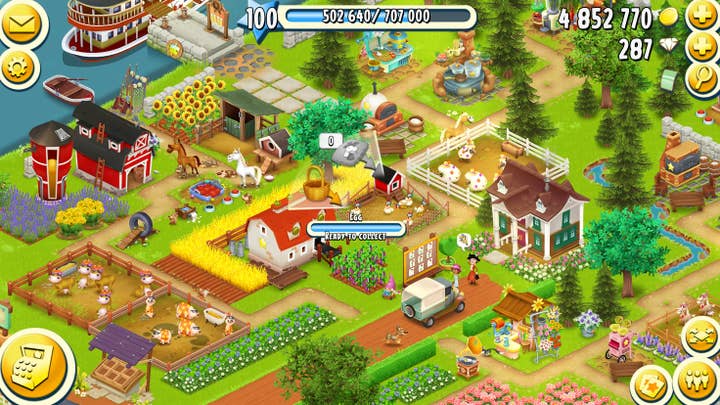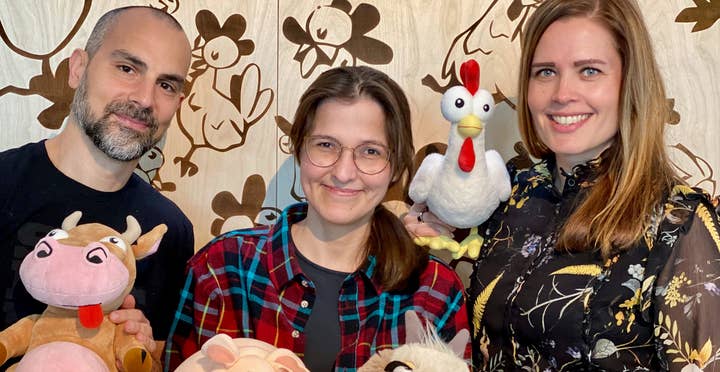Sowing the seeds of stability: Ten years of Supercell's Hay Day
Game lead Stephan Demirdjian, designer Camilla Avellar and artist Sari Latvala discuss the lifespan of the farming hit
Ten years ago, Finnish mobile outfit SuperCell launched Hay Day, its mobile-centric answer to the social farming trend that was dominating the market at the time.
This month, the game celebrates its tenth anniversary -- and it's still going strong despite significant evolution in the mobile space.
Since 2014, the game has generated around 332 lifetime downloads, and approximately $1.7 billion in player spending. In 2021, Hay Day saw a 35% increase in revenue year-over-year, making $183 million following the introduction of its premium farm pass, according to Sensor Tower.
While it continues to evolve and offer new content for new and long-time players alike, the core Hay Day team considers the game a well oiled machine that is self-sustaining.
"I feel like Hay Day is in a good state right now as it has so many things for players to do, and it has such a loyal fanbase," Hay Day game designer Camilla Avellar tells GamesIndustry.biz. Avellar worked on the title between 2014 and 2021, but is now building another project within the Finnish firm.
"So many people still play it every day that it feels like this solid game that can run itself almost."
While Zynga and Facebook had cornered the genre on social media with FarmVille, Hay Day was among the first to offer a mobile alternative to the hugely popular genre, which set it apart from a lot of competitors in the space.
"We were very early to the market with Hay Day," Avellar says. "And we really tried to make it feel native to mobile, it was very touch based. We weren't trying to imitate a mouse cursor, we were making it for your hand, and I feel like that really set us apart from what existed back then."

Stephan Demirdjian, who has served as game lead on Hay Day since 2012, explains how Supercell's commitment to crafting a mobile experience drove some of the in-game design decisions.
"I think that was one of the reasons there was no player avatar in the game, because you are controlling everything," Demirdjian says. "Once the team realised how good it feels to actually sow and harvest the crops, for example, that was a really big thing. It feels like a small thing in hindsight, but I think it was a really impactful moment back then."
While Supercell has a roster of successful IP on mobile now -- from Brawl Stars to the Clash franchise -- Hay Day was the first of its mobile games to break out. The company had tried making Facebook games to little avail; while Hay Day was in development in 2011, Supercell was closing the doors on Gunshine, a zombie MMO integrated with the social network.
"We always had great freedom, but also the responsibility from a company point of view to develop the game as we see fit"
Stephan Demirdjian
Hay Day's success became a firm motivation to go all in on mobile, and the game swiftly became part of a hat trick of hits for Supercell, with the same-year launch of Clash of Clans, and Boom Beach in 2014. While the studio soon had more than one hit to take care of, Hay Day did not suffer, according to Demirdjian.
"We always had great freedom, but also the responsibility from a company point of view to develop the game as we see fit," he says. "We always had the resources and everyone that we needed to make the game or develop the game further in the direction we always dreamed of.
"I don't remember really ever studying the other games in the market, because there was always so much fresh blood in the team and fresh ideas. The backlog became like a meme inside the team. Every time there was a great idea it was like 'Let's put on the backlog, how many years will it take to get to that point?'"
The evolution of the mobile market in the last ten years has altered player expectations, and what users demand from their experience is very different now to when Hay Day launched.
"We were very content driven during the first two years at least, because we didn't have enough time to create the content for the higher levels," Demirdjian explains. "Players were burning through those levels faster than we were able to keep it up.
"When we got to the point where we felt like high level players have enough to do, the mindsets started shifting to more new features and new experiences within the game."

One of those experiences was turning Hay Day into a social experience, and creating multiplayer elements for players.
"We looked at how to tighten the social aspects, and how to turn the game into something for a community of players and not just one player, as well as how other players would meet each other," adds Latvala.
Demirdjian says that players' demands began to change after the first social features were implemented, such as the neighbourhoods (an area that up to 30 players can share), the Derby (a competitive game mode available to neighbourhoods) and more recently, the valley: a new area where players can socialise and take part in events that other users can assist in.
"Through those new things, players saw what is actually possible in the game, and it also opened up more ideas of what they want from us," he says.
Even though the Hay Day team has mastered its content output, players do still constantly want new things to do, according to Avellar.
"Players always want more crops and animals in the game, but over the years, they've also tuned into quality of life demands"
Camilla Avellar
"They want to see more crops in the game, more animals in the game -- that is something that has stayed throughout," she says. "But over the years, they also tuned into the quality of life demands and things that would help them do things easier. Players have leaned more into the experience side, giving us ideas for how to improve it for them."
Demirdjian acknowledges that every new feature won't be used by every player, so variety is key. He says the key to retaining players is creating habits, by organising content into weekly releases, and encouraging them into a light schedule that also integrates with what other players are doing.
"Over the years, we have tried to always implement something new for the players who aren't as social, in the beginning or throughout these years," Latvala adds. "The valley aimed to strengthen social bonds so more people can interact with each other if they don't play the Derby, which can be seen as quite competitive."
The Derby was introduced back in 2015, a week-long event that pits up to 15 neighbourhoods of players against each other in a league. To progress, players must work together to complete tasks and earn points. The event turned an otherwise calm and mindful game almost into a competitive sport.
"I will always remember those moments vividly because we were not even sure whether it was a good idea," Demirdjian recalls. "It took a lot of discussions within the team, we wondered if it made sense to have competitive elements in a farming game, and what kind of challenges it would open up for us as a team.
"I believe we were able to find a really exciting design that actually energised the team, even those that were unsure at first. I was also not fully on board. Nowadays competition is so natural but back then it was a really new thing, and it eventually ended up becoming a crucial element of the game for a large fraction of the audience."
Avellar also said that she was another person on the team that didn't think the competitive element would work.
"The Derby really changed [Hay Day]. It went from a farming game where you consume content to a social game where you have a lot of things to do every week."
Camilla Avellar/citation>
"I thought, 'the players are very casual, they're not going to like this', but what we tried to do as a team was ask what competition is in the casual game," Avellar says. "It cannot be head to head to the death competition, it has to be casual competition."
"I feel like because of these team concerns, we ended up with a design that really worked for Hay Day, so it was good to have all that dissent. The Derby really changed how players played the game. It went from a farming game where you consume content to a social game where you have a lot of things to do every week."
Competitive gameplay is now much more common in mobile games, especially in later Supercell titles. Brawl Stars is a battle royale, Boom Beach requires combat strategy, and Clash of Clans sees players building armies to topple their opponents and defend themselves from a similar fate. With the rise of games that see players fighting each other instead of working collaboratively, was there a concern that the farming genre had dwindled?
"We always had such a loyal fanbase that energised us, so I never thought about the genre itself declining or rising on the market," Demirdjian says. "From my point of view, it was just focusing on the audience that we had, getting additional players in, and trying to improve the game."
The stability of Hay Day has also never been in question, owing to its consistent playerbase.
"I don't remember a year that we would have been scared of what's happening because it was so stable," Latvala explains. "We were planning and we are still planning the updates three or four times a year so that the content keeps coming for the players in good amounts."
Avellar concurs that stability is the key aspect of Hay Day, and also adds that the team behind it feels strong because no one was forced to work on it. A majority of them also played the game themselves.
"Everyone was, if not super excited about the game, at least excited about being in the team and excited about the work," Avellar tells us. "Our team style was always very collaborative, and we had this big overview of what the experience of the game was because we were playing either on the casual side or on the hardcore side. We knew what it felt like as players, and we knew kind of where to go because we were players."
Demirdjian acknowledges that Hay Day would not have experienced a decade of success without the playerbase that it has, but also looks to the diversity of its core team as another reason for its longevity.
"I felt like we already had a lot of diversity from the beginning with different nationalities, different genders, and different belief systems, so I never saw the need to look for ideas outside of the team, because there were always so many interesting voices and ideas," Demirdjian says.
"The team itself for me is one of the key pillars for the stability that we were and are still able to generate for the game."

